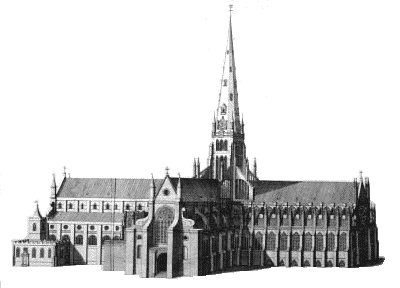|
The Cathedrals
When you think of the medieval church, you probably think of a cathedral. These massive structures sprung up all over  Western Europe, particularly England and France. Cathedral builders competed with one another for size and magnificence. Western Europe, particularly England and France. Cathedral builders competed with one another for size and magnificence.
Old St. Paul's in London, pictures above, was 585 feet in length. Winchester Cathedral was only slightly less, at 526 feet. Notre Dame, in Paris, was 110 feet high; Chartres, 114 feet; Rheims, 125 feet; and Beauvais, 154 feet. A couple of hundred cathedrals were built in the Gothic style during the 13th and 14th centuries.
The cathedrals were usually built in the highest part of a city, dominating the houses clustered below, contrasting the vast wealth of the church with the abject poverty of the masses who contributed to its construction.
The structure of the Gothic cathedral is light and soaring, pointed arches yielding a sense of reaching up towards heaven.Inside some there was mystery, in others light. Stained glass windows glowed, and every inch of stonework or glass was sculpted, carved, painted, or adorned.
The Builders
It is sometimes suggested that pious citizens joined in voluntary labor to build the cathedrals, but the truth is that the construction was tightly organized, well financed, and managed professionally. Neither the priests nor the people joined in on the construction. Masons traveled from one site to another, guarding their craft. This is the origin of the Freemasons we have today, and their original connection with the church.
 Usually, the bishop found a master mason to take on the job. The mason was the designer, builder, and manager of the project. Among the English master masons were Master Robert, who built St. Albans; William of Sens, who supervised the construction of Canterbury; and William of Colchester, the builder of York cathedral. Usually, the bishop found a master mason to take on the job. The mason was the designer, builder, and manager of the project. Among the English master masons were Master Robert, who built St. Albans; William of Sens, who supervised the construction of Canterbury; and William of Colchester, the builder of York cathedral.
Craftsmen were recruited from the various guilds, and paid well for their efforts. To finance the construction, the bishop had to raise large amounts of cash, often by selling spiritual privileges and employing fundraisers. It was a scandal that arose around the selling of indulgences to finance the construction of St. Peters Cathedral at Rome that provoked Martin Luther to action. A cathedral housing a popular shrine, such as that of Thomas Becket at Canterbury, could earn cash from the entrance fees that were charged of the visiting pilgrims.
Apart from the pilgrims, the cathedral was used for worship by the resident monks or canons. The average Christian did not take part in cathedral worship.
The nave was often used by merchants, as a meeting place; and for strangers to sleep. Plays would be staged on the cathedral steps and, in small rooms off the nave, altars were set up for saying masses for the dead, funded by wealthy citizens or guildsmen.
|
